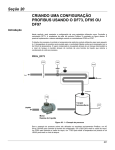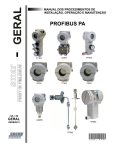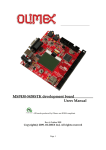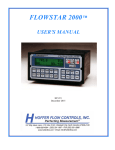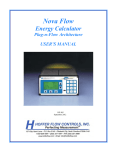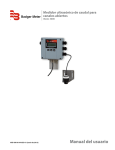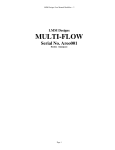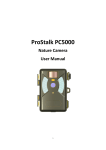Download Model HIT-4U Rate Indicator/Dual Totalizer
Transcript
Model: HIT-4U
Rate Indicator & Dual Totalizer
With MODBUS & Data Logging
USER’S MANUAL
HP- 327
July 2015
________________________________________________________
NOTICE
Hoffer Flow Controls, Inc. makes no warranty of any kind with regard to this
material, including, but not limited to, the implied warranties of merchantability
and fitness for a particular purpose.
This manual has been provided as an aid in installing, connecting, calibrating,
operating, and servicing this unit. Every precaution for accuracy has been taken in
the preparation of this manual; however, Hoffer Flow Controls, Inc. neither
assumes responsibility for any omissions or errors that may appear nor assumes
liability for any damages that result from the use of the products in accordance
with information contained in the manual.
HOFFER FLOW CONTROLS' policy is to provide a user manual for each item
supplied. Therefore, all applicable user manuals should be examined before
attempting to install or otherwise connect a number of related subsystems.
During installation, care must be taken to select the correct interconnecting wiring
drawing. The choice of an incorrect connection drawing may result in damage to the
system and/or one of the components.
Please review the complete model number of each item to be connected and locate
the appropriate manual(s) and/or drawing(s). Identify all model numbers exactly
before making any connections. A number of options and accessories may be added
to the main instrument, which are not shown on the basic user wiring. Consult the
appropriate option or accessory user manual before connecting it to the system. In
many cases, a system wiring drawing is available and may be requested from
Hoffer Flow Controls.
This document contains proprietary information, which is protected by
copyright. All rights are reserved. No part of this document may be photocopied,
reproduced, or translated to another language without the prior written consent
of Hoffer Flow Controls, Inc.
HOFFER FLOW CONTROLS’ policy is to make running changes, not model
changes, whenever an improvement is possible. This affords our customers the
latest in technology and engineering. The information contained in this
document is subject to change without notice.
THIS WARRANTY IS EXPRESSLY IN LIEU OF ALL OTHER WARRANTIES,
EXPRESSED OR IMPLIED, INCLUDING ANY IMPLIED WARRANTY OF
MERCHANTABILITY OR FITNESS FOR A PARTICULAR PURPOSE. HFC SHALL
NOT BE LIABLE FOR ANY LOSS OR DAMAGE RESULTING, DIRECTLY OR INDIRECTLY,
FROM THE USE OR LOSS OF USE OF THE GOODS. WITHOUT LIMITING THE
GENERALITY OF THE FOREGOING, THIS EXCLUSION FROM LIABILITY EMBRACES THE
PURCHASER'S EXPENSES FOR DOWNTIME OR FOR MAKING UP DOWNTIME, DAMAGES
FOR WHICH THE PURCHASER MAY BE LIABLE TO OTHER PERSONS, DAMAGES TO
PROPERTY, AND INJURY TO OR DEATH OF ANY PERSONS. HFC NEITHER ASSUMES
NOR AUTHORIZES ANY PERSON TO ASSUME FOR IT ANY OTHER LIABILITY IN
CONNECTION WITH THE SALE OR USE OF HFC'S GOODS, AND THERE ARE NO ORAL
AGREEMENTS OR WARRANTIES COLLATERAL TO OR AFFECTING THE AGREEMENT.
PURCHASER'S SOLE AND EXCLUSIVE REMEDY IS THE REPAIR AND/OR REPLACEMENT OF
NONCONFORMING GOODS AS PROVIDED IN THE PRECEDING PARAGRAPHS. HFC SHALL
NOT BE LIABLE FOR ANY OTHER DAMAGES WHATSOEVER INCLUDING INDIRECT,
INCIDENTAL, OR CONSEQUENTIAL DAMAGES.
HFC 9907-A
________________________________________________________________
LIMITED WARRANTY POLICY FOR HOFFER FLOW CONTROLS
________________________________________________________________
HOFFER FLOW CONTROLS, INC. ("HFC") warrants HFC's Precision Series and API
Series of turbine flowmeters to be free from defects in material and workmanship under
normal use and service, only if such goods have been properly selected for the service
intended, properly installed and properly operated and maintained as described in the
turbine flowmeter manual. Reference "turbine flowmeter manual" for specific details. This
warranty shall extend for a period of five (5) years from the date of shipment to the
original purchaser and covers the Precision Series and API Series of flowmeters supplied
with their standard hybrid ceramic ball bearings only. All other HFC products carry a one
(1) year warranty. This warranty is extended only to the original purchaser ("Purchaser").
Purchaser's sole and exclusive remedy is the repair and/or replacement of nonconforming
goods as provided in the following paragraphs.
In the event Purchaser believes the Hoffer product is defective, the product must be
returned to HFC, transportation prepaid by Purchaser, within the appropriate warranty
period relative to the product. If HFC's inspection determines that the workmanship or
materials are defective and the required maintenance has been performed and, has been
properly installed and operated, the product will be either repaired or replaced, at HFC's
sole determination, free of additional charge, and the goods will be returned, transportation
paid by HFC, using a transportation method selected by HFC.
Prior to returning the product to HFC, Purchaser must obtain a Returned Material
Authorization (RMA) Number from HFC's Customer Service Department within 30 days
after discovery of a purported breach of warranty, but not later than the warranty period;
otherwise, such claims shall be deemed waived. See the Return Requests/inquiries Section
of this manual.
If HFC's inspection reveals the Hoffer product to be free of defects in material and
workmanship or such inspection reveals the goods were improperly used, improperly
installed, and/or improperly selected for service intended, HFC will notify the purchaser in
writing and will deliver the goods back to Purchaser upon receipt of Purchaser's written
instructions and agreement to pay the cost of transportation. If Purchaser does not respond
within thirty (30) days after notice from HFC, the goods will be disposed of in HFC's
discretion.
HFC does not warrant the product to meet the requirements of any safety code of any
state, municipality, or other jurisdiction, and Purchaser assumes all risk and liability
whatsoever resulting from the use thereof, whether used singlely or in combination with
other machines or apparatus.
This warranty shall not apply to any HFC product or parts thereof, which have been
repaired outside HFC's factory or altered in any way, or have been subject to misuse,
negligence, or accident, or have not been operated in accordance with HFC's printed
instructions or have been operated under conditions more severe than, or otherwise
exceeding, those set forth in the specifications.
________________________________________________________________
FOR NON-WARRANTY REPAIRS OR CALIBRATIONS, consult HOFFER FLOW CONTROLS
for current repair/calibration charges. Have the following information available BEFORE
contacting HOFFER FLOW CONTROLS:
1. P.O. number to cover the COST of the repair/calibration,
2. Model and serial number of the product, and
3. Repair instructions and/or specific problems relative to the product.
________________________________________________________________
HFC 9907-A
CONTENTS
1. INTRODUCTION ------------------------------------------ 1 Model Number Designation ------------------------------- 3 2. FEATURES AND SPECIFICATIONS ----------------- 5 2.1 General ------------------------------------------------- 6 2.2 Inputs --------------------------------------------------- 7 2.3 DC Power/Loop Powered --------------------------- 7 2.4 Analog Output ------------------------------------------ 7 2.5 Pulse Output -------------------------------------------- 8 2.6 Alarm Out with Dual Set Point --------------------- 8 2.7 Serial Port RS485 -------------------------------------- 8 2.8 Data Logging-------------------------------------------- 8 2.9 Physical -------------------------------------------------- 8 3. INSTALLATION ------------------------------------------- 9 3.1 4-20 mA Current Loop ----------------------------- 14 3.2 Analog Output Update Time ---------------------- 15 3.3 Pulse Output ------------------------------------------ 16 3.4 Alarm Output----------------------------------------- 17 4. CONFIGURATION -------------------------------------- 19 4.1 Local Configuration --------------------------------- 19 4.2 Default Configuration------------------------------- 26 5. OPERATION ---------------------------------------------- 27 5.1 Front Panel -------------------------------------------- 27 5.2 Saving Total ------------------------------------------- 27 5.3 Clearing the Total------------------------------------ 28 5.4 Displaying Logs--------------------------------------- 28 5.5 Fault Conditions ------------------------------------- 29 5.6 Battery Replacement -------------------------------- 29 6. MODBUS COMMUNICATIONS --------------------- 31 7. HIT-4 COMMUNICATION PROGRAM ----------- 37 8. MAINTENANCE ----------------------------------------- 49 HIT-4U
HP-327
This page intentionally left blank
HIT-4U
HP-327
Introduction
1
1. INTRODUCTION
The HIT-4U is a battery or loop-powered microprocessor-based flow
rate indicator and totalizer with data logger and MODBUS
Communications Protocol. The instrument can accept a low-level
signal from a magnetic type pickup coil, a DC pulse signal, or contact
closure. Pulses from the signal input are converted into volume and
rate values based on flowmeter calibration settings stored in the
instrument. The total volume and flow rate are displayed on a two-line
liquid crystal display (LCD). A 4-20 mA analog signal proportional to
the flowrate is output on the current loop. The HIT-4U is configurable
from the instrument front panel keypad or via MODBUS
communications.
HIT‐4U
HOFFER FLOW CONTROLS, INC
ELIZABETH CITY, NC
WWW.HOFFERFLOW.COM
00000000
LOW BAT
x1000
00000
GAL L
LB KG
ACF M3
SCF NM3
BBL
/MIN
/HR
/DAY
UNCOMPENSATED
M
Figure 1 – HIT-4U Front Panel
Optional features include 12-point linearization to correct flow meter
non-linearity, a Scaled Pulse Output and Alarm Output configurable for
Rate or Total.
The instrument is housed in an Ex proof enclosure for hazardous areas,
which may be wall mounted or directly mounted on a flowmeter using
an optional riser.
HIT-4U
HP-327
2 Introduction
This instrument is designed to conform to the EMC-Directive of the
Council of European Communities 89/336/EEC and the following
standards:
Generic Emission Standard EN 61000-6-3
Residential, Commercial & Light Industry Environment.
Generic Immunity Standard EN 61000-6-1
Residential, Commercial & Light Industry Environment.
Electrostatic discharge requirements EN 61000-4-2
Radiated, radio-frequency, electromagnetic immunity EN 61000-4-3
Electrical fast transient/burst requirements EN 61000-4-4
Immunity to conducted disturbances EN 61000-4-6
HIT-4U
HP-327
Introduction
3
MODEL NUMBER DESIGNATION
MODEL HIT-4U
RATE INDICATOR & DUAL TOTALIZER
WITH MODBUS & DATA LOGGING
MODEL HIT-4U-( A )-( B )-( C )-( D )-( E )-( F )-( G )
ENCLOSURE STYLE
INPUT POWER
PULSE INPUT
PULSE OUTPUT
ALARMS
MOUNTING
SPECIAL FEATURES
ENCLOSURE STYLE
MODEL HIT-4U-( A )-(
OPTION ( A )
)-(
)-(
)-(
)-(
)-(
(3)*
EXPLOSION-PROOF ENCLOSURE
(7)*
STAINLESS STEEL EXPLOSION-PROOF
)
* OPTIONS FOR ENCLOSURE STYLE 3 AND 7
(_M)
(_S)
M20 CONDUIT THREAD. (NOT ALLOWED FOR USE IN CANADA)
SUNSHADE
EXPLOSION-PROOF ENCLOSURE RATINGS
STYLE 3: CSA/FM:
CLASS I, DIV. 1, GR. ABCD; CLASS II, DIV. 1, GR. EFG;
CLASS III, TYPE 4X; CLASS 1 ZONE 1 AEx d IIC, IP 66
- ATEX/IECEx:
II 2 G Ex d IIC Gb; IP66
STYLE 7: CSA:
- ATEX/IECEx:
CLASS I, DIV. 1, GR. BCD; CLASS II, DIV. 1, GR. EFG;
CLASS III, TYPE 4X, IP66; CLASS 1 ZONE 1 Ex d IIB+H2, IP 66
II 2 G Ex d IIC Gb; IP66
INPUT POWER
MODEL HIT-4U-( )-( B )-( )-( )-( )-( )-( )
OPTION ( B )
(B)
BATTERY POWERED
(L)
4-20MA LOOP POWERED 8-30VDC, WITH BATTERY BACKUP
(D)
DC POWERED 8-30VDC, WITH BATTERY BACKUP (NO ANALOG OUTPUT)
PULSE INPUT
MODEL HIT-4U-( )-( )-( C )-( )-( )-( )-( )
OPTION ( C )
(M)
MAGNETIC COIL, PULSE, DRY CONTACT.
(R)
ISOLATED PULSE, RPM, RPR, HALL EFFECT COILS.
HIT-4U
HP-327
4 Introduction
PULSE OUTPUT
MODEL HIT-4U-( )-( )-( )-( D )-( )-(
OPTION ( D )
(5)*
0-5V TTL/CMOS
(OC)* OPEN COLLECTOR
(V)* PULLUP TO VDC+ IN (8-30VDC)
)-(
)
*INSERT (R) FOR RAW FREQUENCY PULSE OUTPUT
ALARMS - OPTO-ISOLATED ALARMS WITH USER-DEFINED LEVELS FOR RATE
AND/OR TOTAL
MODEL HIT-4U-( )-( )-( )-( )-( E )-( )-( )
OPTION ( E )
(5)
0-5V TTL/CMOS
(OC)
OPEN COLLECTOR
(V)
PULLUP TO VDC+ IN (8-30VDC)
MOUNTING
MODEL HIT-4U-( )-( )-( )-( )-( )-( F )-( )
OPTION ( F )
(FX)
EXPLOSION-PROOF STYLE 3 ENCLOSURES MOUNTED ON
TURBINE. MUST BE USED WITH “X” RISER TURBINE OPTION.
(FXHT)
8" LONG TEMPERATURE RISER FOR EXPLOSION-PROOF
STYLE 3 ENCLOSURES MOUNTED ON TURBINE. REQUIRED
WHEN TEMPERATURES EXCEEDS 140 DEG. F. MUST BE USED WITH
“X” RISER TURBINE OPTION.
SPECIAL FEATURES
MODEL HIT-4U-( )-( )-( )-( )-( )-( )-( G )
OPTION ( G )
(CE) CE MARK REQUIRED FOR EUROPE (PENDING)
(SP)
ANY SPECIAL FEATURES THAT ARE NOT COVERED IN THE
MODEL NUMBER USE A WRITTEN DESCRIPTION OF THE -SP.
HIT-4U
HP-327
Features and Specifications 5
2. FEATURES AND SPECIFICATIONS
LCD display for Total and Rate
Non-resettable Grand Total
Full front panel operation with magnetic pointer via Ex
enclosure
Up to 12-Point Linearization to correct for flowmeter
non-linearity
4-20mA analog output proportional to flow rate
Optional Scaled Pulse Output representing an incremental
total volume
Alarm Output with dual set point configurable for Rate or
Total
Magnetically operated switch for Total reset
Internal 3.6V C-Size battery backup
Configuration and Grand Total stored in non-volatile
memory. Total and Grand Total saved when pressing
►button.
Data Logging: Hourly Total, Daily Total, Event Logs
MODBUS Communications Protocol via RS485
HIT-4U
HP-327
6 Features and Specifications
2.1
General
Display:
LCD, updated every 1 seconds.
Total:
8 digits 3/8" high. Resettable using a magnet, a
dry contact, from front panel keypad or via
MODBUS communications.
Value is stored in non-volatile memory when
pressing ►button.
Total Units:
GAL, LIT, FT3, ACF, ACFx1000, M3, BBL, KG,
LB, NM3, SCF, SCFx1000.
Grand Total:
8 digits 3/8" high, non-resettable. Value is stored
in non-volatile memory when pressing ►button.
Grand Total is displayed for 7 seconds after
pressing the ▲ button.
Rate:
6 digits 1/2" high.
Rate Units:
/SEC, /MIN, /HR, /DAY
K-factor:
The pulses per unit of Total (e.g. pulses/gallon)
are configurable in the range 0.001 to 9,999,999.
Linearization:
2-12 points.
Decimal Points:
Decimal Point positions are configurable for 0,
0.0, 0.00, or 0.000 for rate, total and K-factor.
Accuracy:
Total and Rate: 0.01% of reading, 1 Count
HIT-4U
HP-327
Features and Specifications 7
2.2
Inputs
Magnetic Pickup:
Frequency Range:
Signal Level:
0.2 Hz to 5000 Hz.
30 mVP-P to 30 VP-P.
Opto-Isolated DC Pulse:
Frequency Range:
0 Hz to 3000 Hz.
Signal Level:
0 to +DC pulse.
Internal Pull-Up
10 kΩ to +DC
Low (Logic 0):
< 1 VDC
Min Pulse width:
0.1 msec
Contact Closure:
Frequency Range:
Internal Pull-up:
0 Hz to 5000 Hz
220 kΩ to +3.3 VDC
Reset:
Signal Type:
Contact closure
Min Time On:
Internal Pull-up:
External Magnet
2.3
DC Power/Loop Powered
Voltage:
Current:
Loop Burden:
Supply Backup:
Battery Life:
Protection:
2.4
25 msec
35 kΩ to +3.3 VDC
8 to 30 VDC
< 24 mA
8 VDC maximum
One (1) C-size 3.6V Lithium battery
4 years typical
Reverse polarity protected
Analog Output
Scale:
Accuracy:
Temperature drift:
Update Time:
Connection:
Protection:
HIT-4U
4 – 20 mA follows rate.
0.02% of Full Scale @ 20ºC.
40 ppm/°C
0.125 seconds.
Two wire.
Reverse polarity protected
HP-327
8 Features and Specifications
2.5
Pulse Output
Type:
Divider:
Pulse Width:
Max Frequency:
2.6
Alarm Out with Dual Set Point
Type:
Function:
2.7
MODBUS RTU
Data Logging, Configuration Process
Monitor
Data Logging
Hourly Total Log:
Daily Total Log:
Event Log:
Accessing Logs:
2.9
0-5V TTL, 0-Supply Voltage, Open collector
(30 VDC, 100 mA)
Rate or Total
Serial Port RS485
Protocol:
Function:
2.8
0-5V TTL, 0-Supply Voltage, Open collector
(30 VDC, 100 mA)
0.01, 0.1, 1, 10, 100
Adjustable 4ms to 300ms
100Hz
768
378
345
Vis MODBUS communication
Up to 100 latest logs are viewable on the
front panel
Physical
Temperature:
Humidity:
Packaging:
HIT-4U
Operating: -40°F (-40C) to 158°F (70C).
0 – 90% Non-condensing.
Explosion proof
(Approx. 5"x5"x5", 3 lbs.)
HP-327
Installation
3.
9
I NSTALLATION
Warning: Do not open explosion-proof enclosure while
circuits are powered in hazardous locations.
Field wiring connections
All field wiring connections should be done with shielded cables. The
shield should be connected to the chassis ground lug on the HIT-4U
enclosure. The shield on the opposite end of the cable should be left
open.
Accessing terminal block connection:
1.
Unscrew the cover of the enclosure counter-clockwise until it
separates from the body of the enclosure.
2.
Remove two #4-40 x 1” black oxide screws from the front
panel.
3.
Lift the display assembly from the enclosure. Terminal blocks
are on the bottom.
4.
Use a small flat blade screwdriver and turn counter-clockwise
to loosen the proper terminal screw.
5.
Insert wire and turn terminal screw clockwise to tighten.
6.
Lightly pull on wire to ensure proper connection.
HIT-4U
HP-327
10
Installation
+
‐
Pulse+
Pulse‐
Alarm+
Alarm‐
RS485
RS485
DC+
DC‐
Analog
Load
TB2
A
Magnetic Pickup
Sig+
Sig‐
B
Tx A
Tx B
TB3
TB1
SW1
PCA192
Hoffer Flow Controls
1 2 3 4 5 6
Loop Powered with Magnetic Pickup
+
‐
Pulse+
Pulse‐
Alarm+
Alarm‐
RS485
RS485
DC+
DC‐
Analog
Load
TB2
Sig+
Sig‐
Contact Closure
TB1
SW1
Tx A
Tx B
TB3
PCA192
Hoffer Flow Controls
1 2 3 4 5 6
Loop Powered with Contact Closure
HIT-4U
HP-327
Installation 11
+
‐
Pulse+
Pulse‐
Alarm+
Alarm‐
RS485
RS485
DC+
DC‐
Analog
Load
RediPulse
Pickup
TTL (0‐5VDC)
A
C
B
REG
TB2
Sig+
Sig‐
Tx A
Tx B
TB1
TB3
SW1
PCA192
Hoffer Flow Controls
1 2 3 4 5 6
Loop Powered with RediPulse Pickup (0-5V/TTL)
+
‐
Pulse+
Pulse‐
Alarm+
Alarm‐
RS485
RS485
DC+
DC‐
Analog
RediPulse
Pickup
Open Collector
Load
REG
A
C
B
TB2
Sig+
Sig‐
TB1
SW1
Tx A
Tx B
TB3
PCA192
Hoffer Flow Controls
1 2 3 4 5 6
Loop Powered with RediPulse Pickup (Open Collector)
HIT-4U
HP-327
12
Installation
Pulse+
Pulse‐
Alarm+
Alarm‐
RS485
RS485
DC+
DC‐
Analog
TB2
Magnetic Pickup
A
Sig+
Sig‐
B
Tx A
Tx B
TB3
TB1
SW1
PCA192
Hoffer Flow Controls
1 2 3 4 5 6
Battery Powered with Magnetic Pickup Pulse+
Pulse‐
Alarm+
Alarm‐
RS485
RS485
DC+
DC‐
Analog
TB2
Sig+
Sig‐
Contact Closure
TB1
SW1
Tx A
Tx B
TB3
PCA192
Hoffer Flow Controls
1 2 3 4 5 6
Battery Powered with Contact Closure HIT-4U
HP-327
Installation 13
+
‐
*
RediPulse
Pickup
Open Collector
REG
Pulse+
Pulse‐
Alarm+
Alarm‐
RS485
RS485
DC+
DC‐
Analog
TB2
A
C
B
Sig+
Sig‐
Tx A
Tx B
TB1
TB3
SW1
PCA192
Hoffer Flow Controls
1 2 3 4 5 6
* Jumper is required if 4‐20mA is not connected
DC Powered (no analog output) with RediPulse Pickup
(Open Collector)
+
‐
Pulse+
Pulse‐
Alarm+
Alarm‐
RS485
RS485
DC+
DC‐
Analog
4‐20mA Load
Magnetic Pickup
TB2
A
Sig+
Sig‐
B
TB1
SW1
Tx A
Tx B
TB3
PCA192
Hoffer Flow Controls
1 2 3 4 5 6
Loop Powered with Magnetic Pickup, Alarm and Pulse
Output
HIT-4U
HP-327
14
Installation
Flowmeter Input
The flowmeter input accepts a low-level sinusoidal signal from a
magnetic type pickup coil, contact closure, or a DC pulse signal.
Switches 1,2,3,4,5,6 on SW-1 must be set according to the type of
pickup coil to be used.
SW-1 SWITCH SETTINGS FOR FLOWMETER INPUT OPTIONS
INPUT OPTION
SW-1 SETTINGS
Magnetic pickup
1,2,3 - ON
Contact Closure
4,5,6 - OFF
RediPulse
1,2,3,5 - OFF
TTL
4,6 - ON
RediPulse
1,2,3,6 - OFF
Open Collector
4,5 - ON
3.1
1 2 3 4 5 6
1 2 3 4 5 6
1 2 3 4 5 6
4-20 mA Current Loop
The HIT-4U is powered from a two-wire 4-20 mA current loop. A
minimum supply voltage is in the range of 8-30 Volts DC, depending
on the loop load resistance. At nominal 250 Ohms loop resistance the
minimum power supply is 10.5V.
One C-Size 3.6V Lithium battery is included as a backup power supply
to ensure that volume accumulation will not be interrupted during a
power failure.
HIT-4U
HP-327
Installation 15
Supply Voltage VS Load
1200
1000
Load (Ohms)
800
600
Operating
Region
400
200
0
0
5
10
15
20
25
Supp ly Voltage
The HIT-4U outputs a 4-20mA analog signal that is proportional to the
calculated flow rate. The 4mA and 20mA settings referred to as OUT
LO and OUT HI respectively, may be configured from the front panel of
the instrument or via MODBUS communications.
3.2
Analog Output Update Time
The displayed Rate and Total are updated once per second. The analog
output update time is 1/8 seconds. It takes about .25sec. to reach steady
state due to a change in the input.
When flow stops the time for the display to reach 0 and for the analog
output to return to 4 mA is between 0.25 and 8 seconds, depending on
the Sample Time setting (SMPL T). With the default setting the time is
0.25 seconds.
Changing the SMPL T is only recommended for low flow applications
where the input frequency is below 1 Hz. See Chapter 4 for more
information on Sample Time.
HIT-4U
HP-327
30
16
3.3
Installation
Pulse Output
HIT-4U provides an optional optically isolated Pulse Output factory
configurable for turbine raw frequency or scaled pulse. The scaled
pulse outputs one pulse for the least significant digit of the displayed
total. A scaling factor of 0.01, 0.1, 1, 10 or 100 is available to reduce
or increase the resolution of the pulse output. For example, if the Total
Decimal Point is set to 0000000.0, and the Pulse Scale is 1, then 1
pulse will be output for each tenth (0.1) of a unit of measure. Changing
the Pulse Scale to 10, would result in an output pulse for each 1.0 unit
of measure. The output must be scaled so that the pulse frequency does
not exceed 100Hz at the maximum flow rate.
The pulse width can be configured between 4 and 300ms.
The Pulse Output is factory configured as an Open Collector, 0-5V
(TTL/CMOS), or 0-Vdc+ using internal pull-up resistor.
Pulse and Alarm Output
* Installed only for 5V and +Vdc output options
HIT-4U
HP-327
Configuration 17
3.4
Alarm Output
HIT-4U provides an optional optically isolated Alarm Output
configurable for Rate or Total. The Alarm Output can be configured as
Low Alarm, High Alarm or Low/High.
High Set
Point
Low Set
Point
LOW ALARM
Not Active
Active
HIGH ALARM
LO/HI ALARM
Active
Not Active
Active
Not Active
Active
Flow Rate
Low Set
Point
High Set
Point
Alarm Active – Output transistor is in OFF state
Alarm Not Active – Output transistor is in ON state
The Alarm Output is factory configured as an Open Collector, 0-5V
(TTL/CMOS), or 0-Vdc+ using internal pull-up resistor.
HIT-4U
HP-327
18 Installation
THIS PAGE INTENTIONALLY LEFT BLANK
HIT-4U
HP-327
Configuration 19
4.
CONFIGURATION
The HIT-4U may be configured locally from the front panel, or
remotely using Hoffer HIT-4U Communication program or a
MODBUS master. Front panel configuration may be done with
magnetic pointer through the glass cover, or pressing front panel keys
when cover is off. Do not remove cover in hazardous locations!
4.1
Local Configuration
00000000
LOW BAT
x1000
00000
M
M
HIT-4U
Enters Configuration Mode
Steps through each menu item.
Accepts entry when editing numeric values.
Saves Totals in Operate Mode
Scrolls through Menu Group
Scrolls though all values for each menu item.
Moves to the next digit to the right when editing numeric
values.
Displays Grand Total in Operate Mode Operate Mode
Returns to Operate Mode from Menu Group level.
Returns to Menu Group level from sub level menu.
Increments digit when editing numeric values.
HP-327
20 Configuration
Examples of configuration steps to Clear Total, Set Total, and
displaying software version:
OPERATE
MODE
M
System
Menu
M
NO
Clear Total
Enters Con fig uration
Mode
Next Menu
Gro up
Returns to
Ope rate Mode
Flow
Menu
Next Menu
Item
Next Option
YES
Clear Total
M
Accepts
Sele ction
Done
Clear Total
M
NO
Set Total
M
Next Option
Next Menu
Item
10000000
Set Total
M
Next Menu
Item
Next Digit
Incr eaments Digit
Accepts
Sele ction
10000000
Set Total
Software
Version
HIT-4U
M
Next Menu
Item
HP-327
Configuration 21
Configuration Menu Chart
System
Menu
Flow
Menu
Table
Menu
Output
Menu
Modbus
Menu
Clear
Total
Turbine
Serial #
Number of
points
Analog
Function
Modbus
Address
Set
Total
K Factor
Method
Frequency
2-12 points
Out
Low
Baud
Rate
Software
Version
K Factor
Decimal
K Factor
2-12 points
Out
High
Date
Average
K Factor
Pulse
Function
Time
Flow
Units
Pulse
Width
ID
Number
Total
Decimal
Pulse
Scale
Password
Rate
Units
Alarm
Function
Lock
Unit
Rate
Decimal
Total
Set Point
Sample
Time
Low Cut off
Frequency
Rate Low
Set Point
Contract
Hour
Rate High
Set Point
Hourly
log
Daily
Log
Configuration Fields Description
HIT-4U
HP-327
22 Configuration
SYSTEM MENU
Menu
Item
CLEAR
SETTOT
SW VER
DATE
TIME
ID NUM
PASSWD
LOCK
SMPL T
CONTHR
Description
Clear Total and
save new value
(0) to EEPROM.
Grand Total is
non-resettable.
Set Total and
save to
EEPROM.
Read-only
displays HIT-4U
software version.
Current Date
(mm-dd-yy)
Current time in
24-hour format.
HIT-4U Serial
Number
Password
Password
protected
Sample
Time
Contract Hour
for daily logs
Options
Min
Max
Value
Default
NO
YES
N/A
NO
Numeric
Entry
0
99999999
0
N/a
N/A
N/A
mm-dd-yy
N/A
hh-mm-ss
N/A
Numeric
Entry
0000 –
9999
NO (0)
YES (1)
0
99999999
0000
9999
1234
0000
N/A
NO
1-80
1
80 (8 sec.)
1
1-24
1
1 (1
AM)
HR LOG
Displays Hourly
Logs
Incremental
Scroll ►
DAYLOG
Displays Daily
Logs
Incremental
Scroll ►
HIT-4U
01-0110
23-0000
1
(previous
hour)
99
1
(yesterday)
99
0
(current)
0
(current)
HP-327
Configuration 23
FLOW MENU
Menu
Item
Description
TURBIN
Turbine serial #
K FACT
K Factor Method
KFAC D
AVG K
UNITS
The number of
decimal places for
the K-Factor. For
Average K and K
Factors in table.
Average K Factor
Units of measure
for flow.
LB, KG, SCF,
SCFx1000, and
NM3 have KFactors adjusted at
fixed temperature
and pressure
TOTL D
Total Decimal
Point
RATE
Time base for
flow rate.
RATE D
Rate Decimal
Point
CUTOFF
HIT-4U
Low flow
frequency cutoff
threshold in Hz.
Options
Numeric
Entry
Average
Table
0
0.0
0.00
0.000
Numeric
Entry
Gallons
Barrels
Liters
LB
KG
ACF
ACFx1000
SCF
SCFx1000
M3
NM3
0
0.0
0.00
0.000
/sec
/min
/hour
/day
0
0.0
0.00
0.000
Numeric
Entry
Min
Max
Value
0000000
9999999
N/A
Default
1234567
N/A
0.000
0.001
9999999.9
N/A
1.000
Gallons
N/A
0.0
N/A
/sec
N/A
0.0
0.000
100.000
0.000
Average
HP-327
24 Configuration
TABLE MENU
Menu
Item
Description
POINTS
Number of points
2-12
Frequency points
2 – 12. Follow
monotonic and
separation rules.
Numeric
Entry
Min
Max
Value
2
12
0.001
5000.000
K factor points 2 12
Numeric
Entry
0.001
9999999.9
FR 01
K 01
Options
Default
5
Fr12 =
5000.000
Fr11=
4999.999
Fr10
=49999.998
ETC.
1.000
MODBUS MENU
Menu Item
ADDRSS
BAUD
Description
Modbus address
Baud rate for
RS485
Options
Numeric
entry
*9600
57600
115200
Min
Max
Value
000-254
Default
N/A
9600
*Currently fixed at 9600.
HIT-4U
HP-327
Configuration 25
OUTPUT MENU
Menu Item
ANALOG
OUT LO
OUT HI
PULSE
WIDTH
SCALE
HIT-4U
Description
Analog Out
Function.
4 mA setting in
units selected
for Total .
OUT LO must
be < OUT HI.
20 mA setting in
units selected
for Total. OUT
HI must be >
OUT LO.
Pulse Function
Pulse width in
mS
Pulse Scale.
This factor
represents the
number of
output pulses
per least
significant digit
of displayed
total determined
by the total
decimal
selection.
Options
Default
OFF
RATE
4mA
12mA
20mA
Numeric
Entry
Min
Max
Value
N/A
0.000
999998
0.000
Numeric
Entry
0.001
999999
100.000
OFF
ON
TEST
Numeric
Entry
0.01
0.1
1
10
100
N/A
OFF
4 ms
300 ms
N/A
4 ms
RATE
1
HP-327
26 Configuration
Alarm function.
ALARM
TOTSET
LO SET
HI SET
4.2
Total alarm set
point.
Rate alarm low
set point.
Rate alarm high
set point.
OFF
RATE LO
RATE HI
RATE LOHI
TOTAL
TEST
Numeric
Entry
Numeric
Entry
Numeric
Entry
N/A
OFF
0.001
9999999
0
999999
0
999999
1000.00
10.00
100.00
Default Configuration
HIT-4U is fully configured by the factory prior to shipment. When the
instrument is purchased with a Hoffer Flowmeter or when calibration
and configuration data are supplied, the instrument is configured as
specified. When calibration or configuration data is not available, the
instrument is shipped with default values. Refer to the above table
for a listing of the HIT-4U factory default configuration.
HIT-4U
HP-327
Operation 27
5.
OPERATION
5.1
Front Panel
Total
LOW BAT
x1000
GAL L
LB KG
ACF M3
SCF NM3
BBL
/MIN
/HR
/DAY
Rate
UNCOMPENSATED
M
Operate Mode:
Enters Configuration
Mode
Configuration Mode:
Scrolls through menus
Accepts numerical entry
Operate Mode:
Saves Totals
Operate Mode:
Displays Grand Total
Configuration Mode:
Selects group of menus
Selects value for each menu
Moves to the next digit
Configuration Mode:
Moves one level up
Increments digits
The HIT-4U displays flow total and flow rate on a two-line liquid
crystal display (LCD). The display is updated once per second. The 8digit non-resettable Grand Total can be viewed on the top line
by pressing ▲ key. The Grand Total is displayed for approximately 7
seconds before returning to the Total display.
5.2
Saving Total
Total and Grand Total can be saved at any time by pressing ► button.
When changing the battery (see section 5.6 Battery Replacement), it is
recommended to stop the flow and save Total prior to removing power
from the unit.
HIT-4U
HP-327
Operation
5.3
28
Clearing the Total
The Flow Total may be cleared by using a magnetic pointer, a contact
closure to power common on the RESET input terminal, from the front
panel key, or via MODBUS communications (See Chapter 6 MODBUS
Communications).
To clear the total using a magnetic pointer, slide the magnet slowly
across the HIT-4U model name at the top of the front panel overlay.
To reset the total from the front panel keypad, use the following key
sequence:
Press M
SYSTEM MENU is displayed
CLEAR NO is displayed
CLEAR YES is displayed
CLEAR DONE is displayed
To return to SYSTEM MENU
Press M
Press ►
Press M
Press ▲
Press ▲
5.4
To return to operating mode
Displaying Logs
HIT-4U records up to 768 hourly logs, 378 daily logs and 345 event
logs. Data logs can be red via MODBUS. The newest 99 Hourly and
Daily logs can be displayed on the front panel by accessing the Log
Menu. Event logs can be read only via MODBUS.
Log
Number
OOOOO234
Flow
Total
O1 34
Flow Time
Minutes for Hourly Logs
Hours for Daily Logs
Logs Screen
HIT-4U
HP-327
Operation
29
To access Hourly Logs
Press M
12 times
Press ►
Press ►
Press ▲
Press ▲
HR LOG is displayed
The last recorded log is displayed
Previous log is displayed
To return to SYSTEM MENU
To return to operating mode
To access Daily Logs
Press M
13 times
Press ►
Press ►
Press ▲
Press ▲
5.5
DAY LOG is displayed
The last recorded log is displayed
Previous log is displayed
To return to SYSTEM MENU
To return to operating mode
Fault Conditions
The HIT-4U detects numerous system faults and sends error message
via MODBUS. (Refer to chapter 6. Modbus Communications.)
5.6
Battery Replacement
The HIT-4U monitors the battery voltage and displays LOW BAT on the
LCD when the battery is approaching the end of its life (3V).
The Total and Grand Total is not saved automatically when power is
removed from the HIT-4U.
When changing the battery, it is recommended to stop the flow and
save Total prior to removing power from the unit.
HIT-4U
HP-327
Operation
30
THIS PAGE INTENTIONALLY LEFT BLANK
HIT-4U
HP-327
Modbus Communications
6.
31
MODBUS COMMUNICATIONS
HIT Com Software or a MODBUS Master may be used to configure
HIT-4U, monitor process variables and obtain diagnostic information
from the HIT-4U.
Supported Commands
Function Code
(Hex)
03
05
10
Description
Read holding registers
Preset Boolean (for Enron event record
acknowledgement
Write Commands
Data Types
Data Type
Unsigned Int (U16)
Unsigned Int (U32)
Floating Point (FP32)
Double Precision Float (FP64)
Byte Count
2
4
4
8
Register Count
1
1
1
1
Registers
Each register is labeled as Read Only (RO) or Read/Write (R/W)
according to access type.
Register
(Decimal)
1
3
5
7
32
HIT-4U
Description
Clear Event
Logs
Clear Hourly
Logs
Clear Daily Logs
Clear Grand
Total
Request Event
Logs
Data
Type
U16
Access
U16
RO
U16
RO
U16
RO
U16
(2)
FP32
(4)
RO
RO
Notes
Unpublished - Factory
Only
Unpublished - Factory
Only
Unpublished - Factory
Only
Unpublished - Factory
Only
HP-327
32
Modbus Communications
Register
(Decimal)
700
701
Description
Request Hourly
Logs
Request Daily
Logs
Data
Type
FP32
(4)
FP32
(4)
Access
Notes
RO
RO
1002
Software
Version
FP32
RO
1005
U32
R/W
1 – 99999999
U32
R/W
1 – 99999999
1007
1008
1009
1010
Turbine Serial
Number
Electronic ID
Number
Password
Lock Unit
Slave Address
Baud Rate
U16
U16
U16
U16
R/W
R/W
R/W
R/W
1011
1013
Sample Time
Contract Hour
U16
U16
R/W
R/W
0000-9999
0=No, 1=Yes
0-253
0 = 9600, 1 = 57000, 2
= 115200
1-80
1-24
1200
1201
1202
1203
1204
1205
Year
Month
Day
Hour
Minute
Second
U16
U16
U16
U16
U16
U16
R/W
R/W
R/W
R/W
R/W
R/W
0-99
1-12
1-31
1-24
0-59
0-59
2000
Total Units
U16
R/W
2001
Total Decimal
Point
Rate Time Base
U16
R/W
0=gal, 1=bbl, 2=L, 3=lb,
4=kg, 5=acf,
6=acfx1000, 7=scf,
8=scfx1000, 9=m3,
10=nm3
0-3
U16
R/W
U16
R/W
1006
2003
2004
HIT-4U
Rate Decimal
Point
0=sec, 1=min, 2=hr,
3=day
0-3
HP-327
Modbus Communications
Register
(Decimal)
2005
2006
2007
2008
2010
2011
2013
2015
2017
2019
2021
2023
2025
2027
2029
2031
2033
2035
2037
2039
2041
2043
2045
2047
2049
2051
2053
2055
2057
4000
4001
4003
HIT-4U
Description
K-Factor Method
Average KFactor
Low Frequency
Cutoff
K-Factor
Number of
Points
K-Factor
Decimal Point
Frequency 1
Frequency 2
Frequency 3
Frequency 4
Frequency 5
Frequency 6
Frequency 7
Frequency 8
Frequency 9
Frequency 10
Frequency 11
Frequency 12
K-Factor 1
K-Factor 2
K-Factor 3
K-Factor 4
K-Factor 5
K-Factor 6
K-Factor 7
K-Factor 8
K-Factor 9
K-Factor 10
K-Factor 11
K-Factor 12
Pulse Function
Pulse Width
(mS)
Pulse Scale
33
Data
Type
U16
FP32
Access
Notes
R/W
R/W
0=Average, 1=Linear
0.001-9999999
U16
R/W
0-100 Hz
U16
R/W
2-12
U16
R/W
0-3
FP32
FP32
FP32
FP32
FP32
FP32
FP32
FP32
FP32
FP32
FP32
FP32
FP32
FP32
FP32
FP32
FP32
FP32
FP32
FP32
FP32
FP32
FP32
FP32
R/W
R/W
R/W
R/W
R/W
R/W
R/W
R/W
R/W
R/W
R/W
R/W
R/W
R/W
R/W
R/W
R/W
R/W
R/W
R/W
R/W
R/W
R/W
R/W
0.001-5000.000
0.001-5000.000
0.001-5000.000
0.001-5000.000
0.001-5000.000
0.001-5000.000
0.001-5000.000
0.001-5000.000
0.001-5000.000
0.001-5000.000
0.001-5000.000
0.001-5000.000
0.001-9999999
0.001-9999999
0.001-9999999
0.001-9999999
0.001-9999999
0.001-9999999
0.001-9999999
0.001-9999999
0.001-9999999
0.001-9999999
0.001-9999999
0.001-9999999
U16
U16
R/W
R/W
0=off, 1=on, 2=test
4-300mS
U16
R/W
0=0.01, 1=0.1, 2=1,
3=10, 4=100
HP-327
34
Modbus Communications
Register
(Decimal)
4005
Data
Type
U16
Access
Notes
R/W
FP32
FP32
U16
R/W
R/W
R/W
Total Alarm Set
Point
Rate Alarm Low
Set Point
FP64
R/W
0=off, 1=rate, 2=4mA,
3=12mA, 4=20mA
0.000-999998
0.001-999999
0=off, 1=rate lo, 2=rate
hi 3=rat lohi, 4=total,
5=test
0.001-99999999
FP32
R/W
4014
Rate Alarm High
Set Point
FP32
R/W
7000
Request Hourly
Log Pointer
Request Daily
Log Pointer
Request Event
Log Pointer
Request Date
Request Time
Request Grand
Total
Request Rate
FP32
RO
-1 (cleared logs) - 767
FP32
RO
-1 (cleared logs) - 383
FP32
RO
0-344
FP32
FP32
FP64
RO
RO
RO
010100 - 123199
000000 - 235959
0 - 99999999
FP32
RO
FP64
RO
0 – Max limited by rate
decimal point selection:
999.999, 9999.99,
99999.9, 99999
0 – 99999999
FP32
RO
0 – 86400
FP64
RO
0 – 99999999
4007
4009
4011
4012
4013
7001
7002
7003
7004
7005
7006
7007
7008
7009
HIT-4U
Description
Analog Out
Function
Analog Out Low
Analog Out High
Alarm Function
Request Daily
Total
Request Daily
Run Time
Seconds
Request Hourly
Total
0.001- Max limited by
rate decimal point
selection: 999.999,
9999.99, 99999.9,
99999
0.001- Max limited by
rate decimal point
selection: 999.999,
9999.99, 99999.9,
99999
HP-327
Modbus Communications
Register
(Decimal)
7010
7011
Description
Request Hourly
Run Time
Seconds
Request Current
Total
35
Data
Type
FP32
Access
Notes
RO
0 - 3600
FP64
R/W
0 – Max limited by total
decimal point selection:
99999.999, 999999.99,
9999999.9, 99999999.
FP64
RO
FP32
RO
0 – 86400
FP64
RO
0 – 99999999
FP32
RO
0 - 3600
FP32
RO
-1 (cleared logs) - 767
FP32
RO
-1 (cleared logs) - 383
FP32
R/W
7022
Request Previous
Day Total
Request Previous
Day Run Time
Seconds
Request Previous
Hour Total
Request Previous
Hour Run Time
Seconds
Request Hourly
Download
Pointer
Request Daily
Download
Pointer
Request Event
Log Download
Pointer
Fault History
This register is also used
to clear total by writing
0 or set total by writing
desired value.
0 – 99999999
U32
RO
7023
Active Faults
U32
RO
-1 (cleared logs) – 344
(To increment by one,
use function code 5)
Fault has occurred since
last power on. Each bit
represents a specific
fault defined below.
Fault is currently active.
Each bit represents a
specific fault defined
below.
7013
7014
7015
7016
7018
7019
7020
Fault Codes
HIT-4U
HP-327
36
Modbus Communications
The following table defines each bit for the fault codes returned when
polling register 7022 and 7023 using function code 03. When a value
of 1 is returned for a bit, it indicates that the fault has occurred since
last power on (7022) or is currently active (7023).
Bit
0
1
2
3
4
5
6
7
8
9
10
11
12
13
14
15
16
17
18
19
20
21
22
23
24
25
26
27
28
29
30
31
HIT-4U
Fault
Reset, brownout
Reset, reset pin
Reset, DoBOR
Reset, wakeup from LPM5
Reset, security violation
Reset, supply voltage supervisor low
Reset, supply voltage supervisor high
Reset, supply voltage monitor low
Reset, supply voltage monitor high
Reset, DoPOR
Reset, watchdog timer timeout
Reset, watchdog timer key violation
Reset, flash key violation
Reset, PLL unlock
Reset, peripheral/configuration area fetch
Reset, power management key violation
Low battery
Pulse output overflow
Alarm, rate low
Alarm, rate high
Alarm, total
Flash segment 1 invalid
Flash segment 2 invalid
Maximum input frequency exceeded
EEPROM read error on startup
Code execution error
Flow rate exceeds 20mA setting
Spare 5
Spare 4
Spare 3
Spare 2
Spare 1
HP-327
HIT-4 Communication Program
7.
37
HIT-4 COMMUNICATION PROGRAM
Introduction
Hoffer’s HIT-4 Communication Program allows user to configure HIT4 devices, monitor process variables, read data logs, and obtain
diagnostic information from the HIT-4.
The program can be run without HIT-4 device connected to view and
edit previously saved configuration files and data log files.
System Requirements
PC Windows XP, 7
Installation
Running the HIT-4 Communication Program
Connect HIT-4 device to a computer with either a RS-232 to RS-485 or
USB to RS-485 converter.
HIT-4 port settings:
Baud Rate = 9600
Data Bits = 8
Stop Bits = 1
Parity = none.
The port settings are automatically selected by the program.
To start communication with the HIT-4:
1.
Open the program by clicking on the HIT-4 icon on the
desktop, or navigate the program file located at
C:\Program Files (x86)\Hoffer Flow Controls\HIT-4 and
double click on the file “Hit4Master.exe”. The “Com
Port” screen will appear.
2.
Enter HIT-4 slave address.
3.
Click on the “Connect” button to establish connection to
the HIT-4.
The connection status is displayed in the lower left corner.
HIT-4U
HP-327
38
HIT-4 Maintenance
4.
If the HIT-4 is not connected or the PC serial port is not
configured correctly, the following message will appear in
the Communication Log window on the right side of the
screen:
>HH:MM:SS AM OR PM: The PortName cannot be
empty. Parameter name: PortName
Shut down the software, connect the HIT-4 to the PC and
launch the HIT-4 Communication Program software.
5.
If only the USB to Serial cable is attached to the PC, when
the “Connect” button is clicked the following error will
occur:
Click “OK”; connect HIT-4 to the USB to serial cable,
click on the “Disconnect” and click “Connect”.
6. When communication is established with HIT-4 the
Connecting to device widow will appear:
Click “Yes” to read HIT-4 configuration information.
Once the configuration has been successfully read, the
following window will pop-up:
HIT-4U
HP-327
HIT-4 Communication Program
39
Search for Connected Devices
If multiple HIT-4 devices are daisy chained together in a network, the
Auto Search feature located on the “Com Port” screen provides the
ability to search for all connected devices.
To select a device from a network perform the following:
In the Auto Search enter a numeric value for “Start Address” and
“Stop Address”.
Click “Search for Devices”. The software will scan all addresses in
the specified range and display all connect devices in the “Found
Devices” field as well in the “Slave Address” drop down box.
Select the desired device address from the “Slave Address” drop
down box.
Click on the “Connect” button to establish communication with the
field device.
HIT-4U
HP-327
40
HIT-4 Maintenance
Configuration of the HIT-4
In order to configure the HIT-4 click on the “Configuration” menu
selection that will open the “System Settings” page.
System Settings Page
ID Number:
Enter the HIT-4 serial number. Valid entries are 0 through
99999999
Password:
Enter desired numeric password. Valid entries are 0000
through 9999.
Lock Unit:
Determines whether unit is password protected. Selection
options:
No = not password protected
Yes = password protected
Sample Time:
Set maximum time to hold the display and analog output.
Valid entries are 1 to 80, where 80 represents 8.0 seconds.
Contract Hour:
Determines the time when the daily log begins. Valid entries
are 1 to 24.
Set Total: Set Total to user defined value. Valid entries 0 to
99999999.
HIT-4U
HP-327
HIT-4 Communication Program
41
Flow Settings Page
The Flow Configuration screen is used to configure all parameters
related to the flowmeter calibration.
Turbine Serial #:
Numeric entry of Flowmeter serial number. Valid entries
0000000 to 9999999
Units:
Units of measure for flow. Select Gal, BBL, L, LB, KG, ACF,
ACFx1000, SCF, SCFx1000, M3 and NM3.
Total Decimal:
Sets location of the Total decimal point. Select 0, 1, 2 or 3.
Rate Time:
Selects the flow rate time base. Select sec, min, hour or day.
Rate Decimal:
Sets location of the Rate decimal point. Select 0, 1, 2 or 3.
Cutoff Frequency:
The frequency cutoff threshold in Hz. The HIT-4 will ignore
an input frequency that is below this user entered value. Valid
entries are 0.000 to 100.000.
HIT-4U
HP-327
42
HIT-4 Maintenance
K-Factor Decimal:
Sets location of the K-Factor decimal point. Select 0, 1, 2 or 3.
Table Points:
Set the number of points to be used for the linearization table.
Valid entries are 2 to 12.
Average K-Factor:
Enter the average flowmeter K-Factor. Valid entries are 0.001
to 9999999.
K-Factor Method:
Select flowmeter linearization method as “Average” (single
K-Factor) or “Linear” (2 to 12 point linearization table).
Outputs Page
The Outputs Configuration screen is used to configure the Analog,
Alarm and Pulse outputs.
Analog Output:
Drop down menu selection:
Off:
turns off analog out
Rate: turn on analog output proportional to flow rate
4mA: sets output to 4mA for diagnostic testing
12mA: sets output to 12mA for diagnostic testing
20mA: sets output to 20mA for diagnostic testing
HIT-4U
HP-327
HIT-4 Communication Program
43
Out Low:
Sets flow rate value for 4mA output. Valid entries 0.000 to
999998
Out High:
Sets flow rate value for 20mA output. Valid entries 0.001 to
999999
Alarm Output:
Drop down menu selection:
Off: turns off analog out
Rate_low: sets low flow alarm
Rate_high: sets high flow alarm
Rate_lohi: sets low and high flow alarm
Total:
sets total alarm
Test:
sets alarm output for diagnostic testing
Low Set:
Sets flow rate value for low flow alarm. Valid entries 0 to
999999
High set:
Sets flow rate value for high flow alarm. Valid entries 0 to
999999
Total Set Point:
Sets total alarm set point. Valid entries 0 to 99999999
Pulse Output:
Drop down menu selection;
Off: turns off pulse out
On
turns on pulse out
Test: outputs a test frequency of 1Hz, 50% duty cycle
Pulse Width:
Sets the pulse width in mS. Valid entries 4mS to 300mS.
Pulse Scale:
Pulse scaling that represents the number of output pulses per
least significant digit of displayed total determined by the total
decimal selection. Valid entries 0.01, 0.1, 1, 10 and 100.
HIT-4U
HP-327
44
HIT-4 Maintenance
Configuration Files
HIT-4 Communication Program Software allows the configuration of the
device to be saved as a text file for future use. Configuration files may be
saved from any of the configuration screens. The two available file
functions are:
File Open:
Opens a previously saved configuration file. File format is *.txt.
File Save:
Saves the configuration as a text file.
Download the Configuration
Once all the required parameters have been programmed, the
configuration may be downloaded to the HIT-4 by clicking on the
“Download” button located on the bottom of any of the configuration
screens.
Note:
As each configuration parameter is entered, the parameter is
automatically sent to the HIT-4.
Upload the Configuration
Clicking of the “Upload” button located on the bottom of any of the
configuration screen will read the configuration data from the unit.
Printing Configuration Files
The configuration may be printed by clicking on the “Print” button
located on the bottom of any of the configuration screens.
When the “Print” button is clicked on the user has the option to select a
printer for printing or saving the configuration as a text file.
HIT-4U
HP-327
HIT-4 Communication Program
45
Process Monitor
The Process Monitor screen allows the user to monitor the process flow
variables. The “Flow Total”, “Grand Total”, “Flow Rate”, “Current Day
Total”, and “Previous Day Total” can be either read once or automatically
updated.
Flow Readings Update:
Clicking on the “Update” button will read and display the “Flow
Total”, “Grand Total”, “Flow Rate”, “Current Day Total”, and
“Previous Day Total”.
Refresh Rate (sec):
Sets update rate in seconds when the Flow Readings are taken in
the automatic update mode.
Start Auto Update:
Click on the “Start Auto Update” button to have the HIT-4
software auto poll the selected device and in real time to update
the “Flow Total”, “Grand Total”, “Flow Rate”, “Current Day
Total”, and “Previous Day Total”.
Stop Auto Update:
Click on the “Stop Auto Update” stops auto updating.
HIT-4U
HP-327
46
HIT-4 Maintenance
Faults
HIT-4 self-diagnostic function records the following fault
Conditions:
Power Reset
Low battery
Pulse output overflow
Alarm, rate low
Alarm, rate high
Alarm, total
Flash segment 1 invalid
Flash segment 2 invalid
Maximum input frequency exceeded
EEPROM read error on startup
Code execution error
Flow rate exceeds 20mA setting
The fault conditions are reported on the Process Monitor page.
Faults currently active are displayed in the “Active” window.
Faults that have occurred in the past, since the last power reset, are
displayed in the “Since Power On” window. The numerical code
displayed above each window is used for factory diagnostics.
HIT-4U
HP-327
HIT-4 Communication Program
47
Data Logs
The HIT-4 records flow data into hourly and daily logs. The data can be
viewed in tabular, graph, save to file, print logs, and to export log data
into an Excel spreadsheet. In addition the Event log allows the user to
identify changes to the configuration parameters.
The Flow Logs and Event Log can be downloaded from the HIT-4 by
clicking on the “Logs” in the menu bar.
The “New Data Logs” field will display the number of new “Hourly
Logs”, “Daily Logs” and “Event Log”.
Logs are downloaded by clicking on the drop down “Select Log” box, and
selecting the desired log to be downloaded. Once the selection has been
made, either click on the “Download New” or “Download All” menu
options.
HIT-4U
HP-327
48
HIT-4 Maintenance
For example; the desired log to be downloaded is the Hourly Log. Select
Hourly Log from the drop down selection box and click on “Download
All”. The following screen will be generated:
From this screen, the user will be able to save the log, export log to Excel
for printing or saving, clear the log, mark records as being read and use
the graph for analyzing the flow volume trends.
Records can be selected either individually or in multiples to be marked as
read. Individual records can be selected by clicking on the furthest left
hand column. Multiple records can be selected by clicking on the first and
last desired records to be marked as read. Selected record(s) will be
highlighted in blue.
Clicking on the “Mark as Read” menu selection will mark all highlighted
records as read, and change the new data logs status.
HIT-4U
HP-327
HIT-4 Communication Program
49
8. MAINTENANCE
Batteries require periodic replacement, and battery life depends on
whether battery power is the primary or secondary power source.
All configuration settings are stored in nonvolatile memory; therefore,
configuration settings will not be lost in the event of battery failure.
Lithium Battery Replacement
WARNING: To prevent ignition of hazardous atmospheres, do
not remove the cover unless the area is void of combustible gas
and vapors. Replace the batteries only with battery part number
100-TDB.
WARNING: The lithium battery that powers the HIT-4U is a
sealed unit; however, should Lithium batteries develop a leak,
toxic fumes could escape upon opening the enclosure. Ensure that
the instrument is in a well-ventilated area before opening the
enclosure to avoid breathing fumes trapped inside the enclosure.
Exercise caution in handling and disposing of spent or damaged
batteries.
Important: Before replacing the lithium battery press the ► key
to save the Total and Grand Total to nonvolatile memory. Once
the battery is replaced and power is restored to the unit, the last
saved Total will be displayed
The lithium battery is secured inside the enclosure by a Velcro strap and
connected to a connector (J3) near the top of the circuit assembly.
To replace a lithium battery in the HIT-4, perform the following steps:
1. Loosen the cover set screw and unscrew the cover of the enclosure
counter-clockwise until it separates from the main body of the enclosure.
2. Using a small standard blade screwdriver, remove the two #4-40 screws
located to the right and left side of the LCD display.
3. Lift the display/keypad assembly from the enclosure, making sure the
circuit assembly does not contact the enclosure.
HIT-4U
HP-327
50
HIT-4 Maintenance
4. Loosen the Velcro strap, disconnect the battery from the J3 connector
on the circuit assembly, and remove the battery from the enclosure.
5. Install the new battery in the enclosure in the same position as the
original battery, and secure the Velcro tightly around the battery.
6. Connect the replacement battery to the J3 connector.
7. Place the circuit assembly over the standoffs and fasten with the two
#4-40 screws, ensuring that all connector wiring is inside the enclosure.
8. Replace the enclosure cover, threading it onto the enclosure in a
clockwise direction.
Important: The interruption of power to the HIT-4 will cause the internal
clock time to be inaccurate.
Reset the date and time via the interactive HIT-4 Communication
program, or manually using the keys.
HIT-4U
HP-327

























































